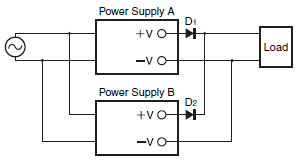What is Backup operation?
Backup operation is used when the output current from a single Power Supply is sufficient, but the system requires protection (backup) by another Power Supply in case the first Power Supply fails or is otherwise inoperative.
Use identical models for Power Supplies A and B.
-
Select the Power Supplies so that either one can supply the required load capacity.
-
When connecting Power Supplies for backup operation, always connect diodes (as shown in the diagram above) to prevent the failure in one Power Supply from affecting the Power Supply that is backing up operation. The following table shows the diode type, dielectric strength, and current characteristics.
Diode type Schottky barrier diode Dielectric strength (VRRM) At least equal to Power Supplies' rated output voltage Forward current (IF) At least twice the rated output current of Power Supplies -
Increase the setting of the output voltages of Power Supplies A and B by the forward voltage (VF) voltage drop of diode's D1 and D2. Also, the diodes will produce a power loss equal to Power Supplies' output current times the diodes forward voltage (IOUT × VF), so provide cooling so that the diode temperature remains below the specified catalog value.
-
Any pair of Power Supplies can be connected for backup operation except for Multi-output Power Supplies.